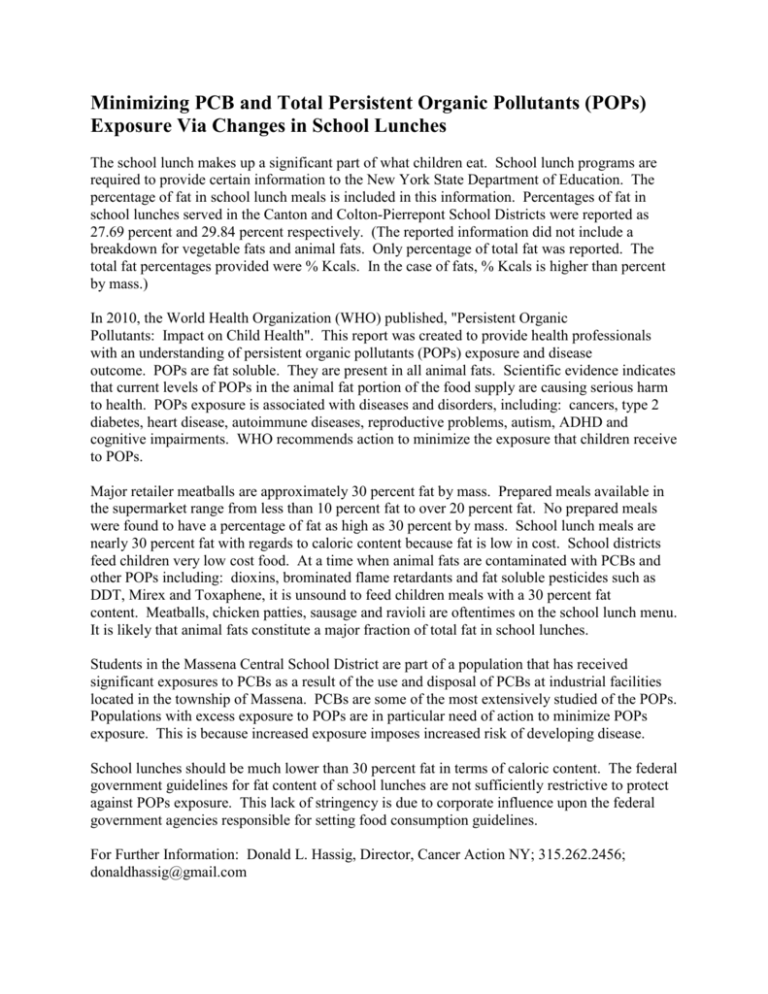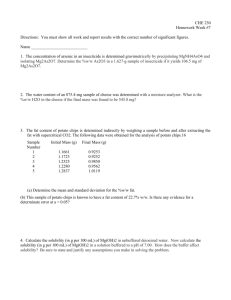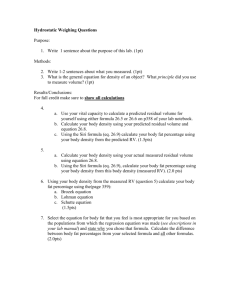Minimizing PCB and Total Persistent Organic Pollutants Via
advertisement

Minimizing PCB and Total Persistent Organic Pollutants (POPs) Exposure Via Changes in School Lunches The school lunch makes up a significant part of what children eat. School lunch programs are required to provide certain information to the New York State Department of Education. The percentage of fat in school lunch meals is included in this information. Percentages of fat in school lunches served in the Canton and Colton-Pierrepont School Districts were reported as 27.69 percent and 29.84 percent respectively. (The reported information did not include a breakdown for vegetable fats and animal fats. Only percentage of total fat was reported. The total fat percentages provided were % Kcals. In the case of fats, % Kcals is higher than percent by mass.) In 2010, the World Health Organization (WHO) published, "Persistent Organic Pollutants: Impact on Child Health". This report was created to provide health professionals with an understanding of persistent organic pollutants (POPs) exposure and disease outcome. POPs are fat soluble. They are present in all animal fats. Scientific evidence indicates that current levels of POPs in the animal fat portion of the food supply are causing serious harm to health. POPs exposure is associated with diseases and disorders, including: cancers, type 2 diabetes, heart disease, autoimmune diseases, reproductive problems, autism, ADHD and cognitive impairments. WHO recommends action to minimize the exposure that children receive to POPs. Major retailer meatballs are approximately 30 percent fat by mass. Prepared meals available in the supermarket range from less than 10 percent fat to over 20 percent fat. No prepared meals were found to have a percentage of fat as high as 30 percent by mass. School lunch meals are nearly 30 percent fat with regards to caloric content because fat is low in cost. School districts feed children very low cost food. At a time when animal fats are contaminated with PCBs and other POPs including: dioxins, brominated flame retardants and fat soluble pesticides such as DDT, Mirex and Toxaphene, it is unsound to feed children meals with a 30 percent fat content. Meatballs, chicken patties, sausage and ravioli are oftentimes on the school lunch menu. It is likely that animal fats constitute a major fraction of total fat in school lunches. Students in the Massena Central School District are part of a population that has received significant exposures to PCBs as a result of the use and disposal of PCBs at industrial facilities located in the township of Massena. PCBs are some of the most extensively studied of the POPs. Populations with excess exposure to POPs are in particular need of action to minimize POPs exposure. This is because increased exposure imposes increased risk of developing disease. School lunches should be much lower than 30 percent fat in terms of caloric content. The federal government guidelines for fat content of school lunches are not sufficiently restrictive to protect against POPs exposure. This lack of stringency is due to corporate influence upon the federal government agencies responsible for setting food consumption guidelines. For Further Information: Donald L. Hassig, Director, Cancer Action NY; 315.262.2456; donaldhassig@gmail.com








